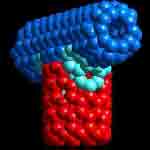 |
 |
Nanomanufacturing Automation
By : Jim Pinto, Nanomanufacturing is the production of materials and the manufacturing of parts either from the "bottom up" from nano-scaled materials, or "top down" in nano steps for high precision. This is revolutionizing industry, impacting almost every manufacturing segment.
February 2013
|
 A decade ago, Business Week named Nanotechnology one of the "Ten Technologies That Will Change Our Lives." This sci-tech revolution is based upon the ability to systematically manipulate and organize matter on the nanometer (less than 1 micrometer) scale.
A decade ago, Business Week named Nanotechnology one of the "Ten Technologies That Will Change Our Lives." This sci-tech revolution is based upon the ability to systematically manipulate and organize matter on the nanometer (less than 1 micrometer) scale.
Nanomanufacturing is the production of materials and the manufacturing of parts from either the "bottom up" from nano-scaled materials or "top down" in nano steps for high precision. This is revolutionizing industry, impacting almost every manufacturing segment - electronics, thin films, chemical synthesis, biotechnology, biomedicine, pharmaceuticals, agriculture, food production, printing and publishing, advanced micro-lithography, plastics, metals, and many others. The radical concept of nanotechnology was first imagined in the mid-1970s by M.I.T. undergraduate K. Eric Drexler, who recognized that the biological "machinery" in nature could be adapted to manufacture just about anything. His book, Engines of Creation, examined how nanotechnology would revolutionize everyday life. At the core of Drexler's vision was a nanomachine called an "assembler" that could "place atoms in almost any reasonable arrangement," allowing the fabrication of almost anything. Assemblers would be capable of replicating themselves exponentially so that the process could be rapid. Manufacturing could use nano-scale materials, structures, devices, systems and molecular-scale components that would spontaneously "self-assemble" from the bottom up into ordered structures. Nanomaterials can be much stronger, lighter, more durable, water-repellent, anti-reflective, self-cleaning, ultraviolet- or infrared-resistant, antimicrobial, scratch-resistant, or electrically conductive. Today's nanotechnology-enabled products range from baseball bats and tennis rackets to catalysts for refining crude oil and ultra sensitive detection and identification of biological and chemical toxins. In the energy arena, nanotechnology enables high-efficiency, low-cost batteries and solar cells. Nano-scale integrated circuits are faster, more powerful and more energy-efficient, and can be extended almost to the ultimate atomic-scale limits. Nano-scale integrated circuit (IC) chips are made from nano-scale logic gates connected by nano-scale wires. This is being used to exponentially increase information storage capacity at very low cost. Growth marketsAs more companies and institutions establish nanotech programs, they will require the tools for R&D and manufacturing. The growth markets will be for improved equipment designed specifically for nanomanufacturing processes.The typical nanotech manufacturing products showcase includes various types of measurement and control systems; for example, positioning systems with travel ranges of a few millimeters up to a few hundred millimeters. Nano-positioning systems are based on frictionless piezo actuators and flexures that can convert electrical energy directly into mechanical energy with virtually unlimited resolution and accuracies down to the sub-nanometer level. Nanomaterial coatings and thin films are applied to the surface of materials to alter their properties. Being able to measure the thickness and uniformity of these thin films is important because variations can affect the properties and performance of the final device. Nano-fiber production equipment is designed for production of fibers with diameters in the submicron range (less than 500 nanometers). Nanomanufacturing is growing into a $1 trillion business. The National Science Foundation estimates that two million skilled workers will be needed worldwide by 2015 - over one million in the United States. Manufacturing companies: Make sure you're not stuck in old manufacturing paradigms. Automation suppliers: Nanotech products and markets should be in your growth development plans. 
|
 Pinto's Points How to win in the Automation Business Go shopping - books, electronics, CD/DVD Selected advertising coming here. Contact Jim Pinto for rates. |
Return to Index of all JimPinto Writings

 Return to JimPinto.com HomePage
Return to JimPinto.com HomePage
If you have ideas or suggestions to improve this site, contact: webmaster@jimpinto.com
Copyright 2006 : Jim Pinto, San Diego, CA, USA
